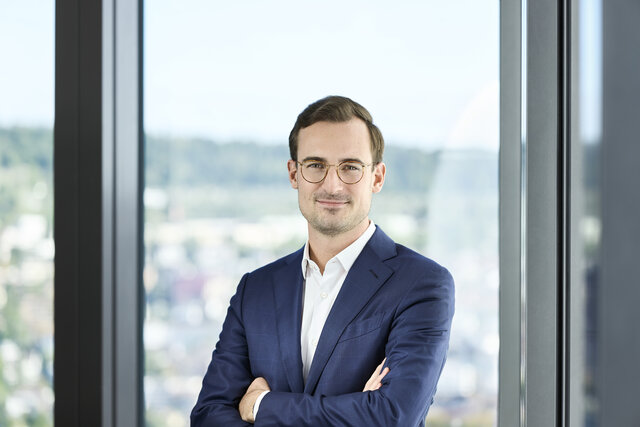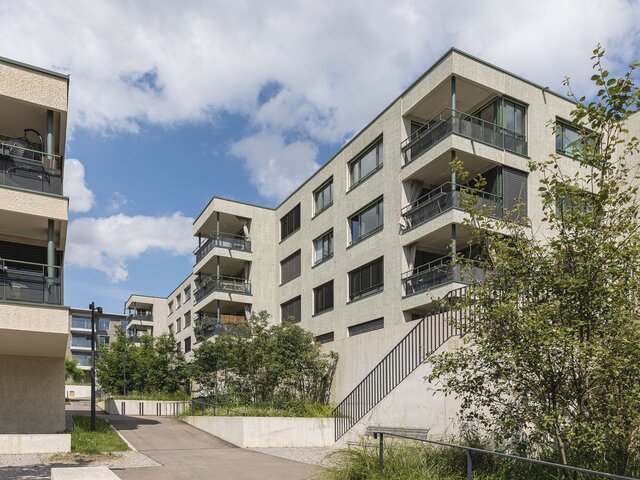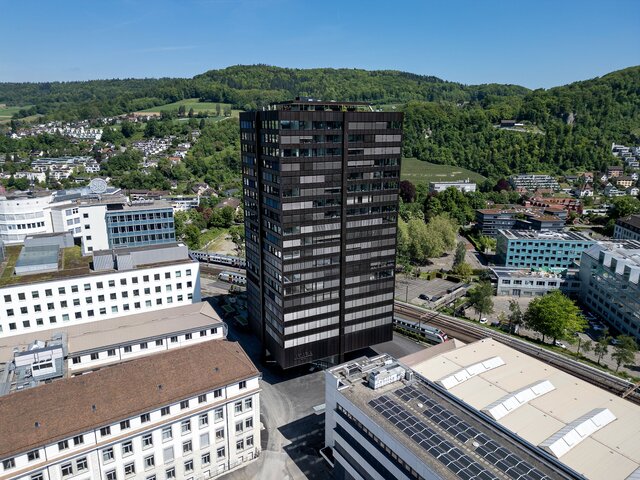

Interest rate shifts, volatile markets, stagnating development – the Swiss real estate sector is facing growing challenges. Christoph Jockers, CIO of the Akara Fund, explains how to generate stable returns in such an environment: with disciplined portfolio management, a long-term perspective, and a keen feel for market undercurrents. A conversation about quality over quantity – and why restraint can sometimes be the better path to growth.
Finews meets Christoph Jockers high above the rooftops of Zurich. From the top floor of the Prime Tower, where Swiss Prime Site Solutions (SPSS) has one of its three offices in Switzerland, a panoramic vista stretches out across the city all the way to Lake Zurich.
Our interviewee is in good spirits as he takes in the impressive view. He has played a key role in the strategic development of SPSS in recent years. Since the beginning of 2025, he has also served as Chief Investment Officer of the Akara Swiss Diversity Property Fund PK (Akara Fund), a real estate fund for pension funds and pension institutions that is soon set to reach CHF 3 billion in assets under management. Swiss Prime Site (SPS) acquired the fund in 2022 and integrated it into its asset management arm, Swiss Prime Site Solutions (SPSS).
Christoph, you have spent your entire career in the real estate sector. What is it that fascinates you about this field?
I have been fascinated by architecture and the built environment ever since I was a child. A defining moment then came during my studies in Rotterdam. The city had been almost completely destroyed during World War II and was later rebuilt in a very pragmatic way. Through the combined efforts of investors, the public and the authorities, it has since been transformed into an innovative and sustainable urban space. This showed me the kind of impact that property owners can have. Being able to play a part in urban transformations like these while also offering investors solid long-term returns is what drives me every day.
For the past three decades, real estate has been seen as a safe investment in Switzerland. Will that be the case forever?
«Forever» is a big word. But there are certain structural factors here in Switzerland that make the property market highly resilient, such as steady population growth, political stability and an attractive economic environment. This creates constant demand for residential and commercial space. However, the real estate sector in Switzerland is also exposed to economic cycles. The past few years have been challenging for the industry, especially due to the numerous interest-rate hikes. But we have emerged even stronger thanks to our high-quality portfolio and professional structures. Being part of SPS has certainly benefited us.
Other countries can develop huge real estate projects on greenfield sites. But here in Switzerland, it feels like more and more is being squeezed into the existing urban footprint.
That really is a key difference. To the east of Vienna, where I was recently, you can easily build a neighbourhood for 25 000 people – with a metro connection that gets you to the centre in ten minutes. In Switzerland, areas like that simply don’t exist, which means that we have to manage the available space responsibly and with foresight.
Switzerland could just build more things vertically, couldn’t it?
That’s something many people say – and it’s certainly part of the solution. But in reality, larger projects often face strong resistance. Take the stadium project in Zurich, for example. It is broadly supported but keeps hitting a brick wall – whether due to political opposition or individual interests. In Switzerland, almost everything involves a compromise. That makes implementation more challenging or even impossible, especially if objections are raised. But when a solution is found, it is usually more sustainable in the long run.
The Akara Fund currently includes 158 properties. How has the portfolio changed since it was integrated into SPSS in 2022?
Interestingly, the number of properties has remained almost the same. But what we have changed is the underlying structure. We analysed the portfolio and then focused specifically on improving its quality, efficiency and resilience. We sold off smaller properties with limited development potential and acquired larger ones with better return prospects. This enabled us to significantly increase the average property size – we are currently at just under CHF 20 million per property.
In other words, you have transformed a private niche player with many smaller assets into an institutional vehicle with scale and structure.
Exactly. The fund was originally positioned between two worlds, with an acquisition profile that spanned both private and institutional investors. Many of the initial properties were residential in the CHF 5 to 10 million range. From today’s perspective, those properties make little operational sense. We sold the houses at good prices – primarily to family offices, which have been more active than institutional investors in the past two years. This capital upcycling has given us the flexibility to pursue new acquisitions and expand our development pipeline.
What is the focus for these acquisitions?
We make targeted acquisitions through our network – ideally off-market – with a focus on quality, income potential and development opportunities. For example, in Plan-les-Ouates near Geneva, we acquired a site with two projects directly from a family office – including a new-build with 93 apartments and a Tertianum property with a long-term lease. These are the kinds of opportunities we look for.
So you didn’t increase the number of properties overall, but you significantly grew the assets under management.
When SPSS took over the fund, the volume was around CHF 2.2 billion. We are now approaching the CHF 3 billion mark. It was important to us to pursue this growth with a sense of proportion, which doesn’t just mean more but better.
You were already at Swiss Prime Site when the acquisition of Akara was being prepared. How did it come about?
Our Group CEO, René Zahnd, defined a clear strategy fairly soon after taking office in 2016: Swiss Prime Site was to sharpen its focus, which meant moving away from property-related holdings such as Tertianum and Wincasa and back to our core business. At the same time, our CEO, Anastasius Tschopp, wanted to strategically expand Swiss Prime Site Solutions. And when we analysed the market as part of this strategic process, it quickly became clear: Akara would be an excellent fit for us at this stage.
What was it that made Akara so attractive?
Akara had a distinctly entrepreneurial character – dynamic, pragmatic and quick in terms of execution. The team had accomplished a great deal, especially in residential property development – an area we were keen to expand even further at SPSS. However, the Akara Group’s setup lacked the structure and scalability that is needed once you reach a certain size. Swiss Prime Site could contribute a lot in this sense.
You have been the CIO of the Akara Fund since the beginning of 2025. How would you describe your role?
There are two sides to my role. One is outward-facing: speaking with investors, understanding their needs, presenting our products. The other is internally focused: working with my team to further develop our strategy – where do we want to go in the next twelve months but also in the medium term, i.e. the next five to ten years? The Akara Fund now has a strong foundation with significant leverage – managing it calls for foresight and clear priorities.
What regional priorities are you focusing on for acquisitions?
Our current focus is on the Zurich region, Northwestern Switzerland – including the canton of Aargau – and the Lake Geneva region. We have recently expanded our activities in the Geneva and Lausanne areas in particular. In addition, we are looking along the A1 corridor between Geneva and Zurich – and perhaps a bit further east – for suitable properties with specific uses, such as commercial sites with good transport links.

«The Akara Fund was founded in 2016 with a clear mission: to offer a professional vehicle for pension and social security institutions.»
What role does the development pipeline play?
It plays a key role. The Akara Fund has a solid track record in project development. We continue to prove this time and again by generating attractive development gains for the fund. Last year, for example, we completed the Moosstrasse project in Zurich-Wollishofen and the second phase of the development in Uitikon-Waldegg. Projects like these make a major contribution to our returns over time through top-line contributions and valuation effects.
What kind of usage diversification is the fund aiming for in the future?
If we were to complete only the existing pipeline without any further acquisitions or disposals, the residential proportion would increase from the current 53 percent to around 60 percent. We are aiming for a balanced mix of 55 to 60 percent residential, with the rest commercial. That’s why we’ll also be making targeted acquisitions in the commercial segment going forward.
The Akara Fund’s returns have diverged from – and outperformed – the KGAST Immo Index «Mixed» in recent years. What are the reasons for this?
We have deliberately built on the strong foundation that was established before the fund was acquired by SPSS. On the one hand, we are working systematically on like-for-like growth in rental income, with a particular focus on optimising new lettings. In some of our development projects, we were able to achieve initial rents that were 10 to 20 percent higher than originally projected. The Akara Tower in Baden and the project in Uitikon-Waldegg are excellent examples – both were real return boosters and confirmed that we are developing the right products in the right locations. On the other hand, we have also focused on financing. When we acquired the fund, it was almost exclusively financed on a short-term basis. In an environment marked by rising interest rates, this drives up costs. Today, around two-thirds of our mortgages are secured with long-term financing. But we still use short-term financing selectively to take advantage of the leverage effect.
How is the fund currently being affected by interest rate changes?
On three fronts: first, in terms of investor demand – the cautious approach of the past two years is now clearly giving way to renewed confidence in real estate investments. Second, in terms of financing costs, where we are benefiting from our new structure. And third, at the property level – properties are generally becoming more expensive again, which places considerable demands on our acquisition network. Given the recent drop in the reference interest rate, we are occasionally faced with requests for rate reductions, which are offset by inflation and market conditions. Overall, the fund is benefiting from the positive interest rate environment.
In the first half of 2024, the investment return was 2.12 percent, significantly above the benchmark index. Is this sustainable?
We are confident that it is. We don’t rely on one-off effects – we focus on the portfolio itself. The cash flow return for the half-year was 1.49 percent. Annualised, this translates to just under 3 percent. And that is also our goal: to achieve three percent on a sustainable basis. Our planning for 2025 and the fact that our development pipeline has been further strengthened by recent acquisitions gives us confidence that we can once again deliver strong results for investors this year.
What else are you doing to improve performance?
Among other measures, we are specifically reducing owner’s costs, such as through operational optimisations to existing properties. One recent example is a commercial property in Volketswil, where we were able to reduce operating costs by 20 percent. This not only benefits the fund as the owner but also the tenants. In addition, we will continue the capital recycling strategy to further improve portfolio quality and efficiency. Such measures have a direct impact on returns and thus directly benefit the investors.
In the medium term, you are aiming to grow the Akara Fund to a volume of CHF 4.5 billion. How do you plan to achieve this?
Our existing development pipeline will make a major contribution. We expect an additional construction volume of around CHF 600 million by 2029 from projects that are already in progress or preparation. We also plan to continue making targeted acquisitions. To facilitate this further growth, we have announced our next capital increase for April 2025 and are already seeing strong interest from investors.
You conduct two capital increases per year. In 2024, each one raised around CHF 40 to 45 million. Why not just raise half a billion at once?
Because we plan with foresight and in close alignment with our investment strategy. Many investors have felt the effects of over-allocation in recent years – such as when the stock markets weakened and real estate suddenly made up over 30 percent of their portfolios. This meant many of them couldn’t continue investing in our product due to internal guidelines, even if they wanted to. The situation is now easing and demand is clearly picking up.
So you are consciously taking a cautious approach?
Yes, and this approach works well for capital increases. The Client Relations team is in close contact with investors and can sense exactly when a capital call is appropriate. At the same time, we want to ensure that the capital we raise can be invested efficiently. Half a billion at once is tempting – but hardly realistic. We want to grow strategically and with substance.
What role do in-kind contributions from pension funds play in this?
They are becoming increasingly important. Many pension funds still hold direct real estate investments – many from the 1980s when the BVV2 regulations allowed such investments for the newly mandatory second pillar of the Swiss pension system. Today, these portfolios often need restructuring and are complex to manage. We therefore offer what are known as in-kind contribution models: the pension fund contributes its real estate to the fund and we take on the professional management. The fund thereby benefits from more diversification and less effort on its part.
Can you provide a specific example?
Yes, in 2023, we acquired a portfolio worth over CHF 120 million from a pension fund. Solutions like these are attractive for both sides.
The Akara Fund is aimed exclusively at tax-exempt pension institutions. Why such a narrow focus?
This was the intention from the very beginning. The fund was designed in 2016 with a specific goal: to be a professional product for pension funds and tax-exempt compensation or social security funds. These institutions are long-term oriented and attach great importance to stability, predictability and transparency. Our fund offers the ideal structure for this.
How does the Akara Fund differ from traditional investment foundations?
We are a regulated investment fund under the Collective Investment Schemes Act and are therefore supervised by FINMA, not the Occupational Pension Supervisory Commission. This means stricter supervision, which creates even more trust among investors. We are also NAV-based, which means there is neither a premium nor a discount. Investors can participate in capital increases at the net asset value, something that is highly appreciated by many of them. Like investment foundations, we are also tax-exempt. Furthermore, we are a distributing fund, which is a big plus for many pension funds. It allows them to cover their ongoing obligations without being forced to sell shares.
Why don’t you open the fund to other qualified investors – such as wealthy private clients?
Because we are consciously positioning ourselves. In Switzerland, there are over 2 000 potential investors within the tax-exempt pension fund sector alone. And we are ideally positioned to serve this segment. The monthly pension contributions that companies pay for their employees often flow into real estate – that’s an estimated CHF 4 to 6 billion per year. This is the space we operate in. If we were to reposition ourselves, it would mean losing the tax exemption that is so crucial to our current investors. It is therefore not an option.
The former Akara Group also had a small business with club deals and private placements. What has become of that?
The corresponding vehicle still exists – a construction project is currently underway within that framework. For club deals and promotions, our future focus at SPSS will be on the vehicles of the former real estate asset management company Fundamenta that we acquired last year and which is very well established in this area.
What do you enjoy most about your role?
For me, it’s a privilege to work with my team on this product. It’s a responsible role, not least because we are working with pension funds. The amounts aren’t just numbers on a screen – they represent the capital of people who have been working all their lives. I take this responsibility very seriously and approach my daily work with a strong sense of duty. If, with our fund, we can deliver stable returns to beneficiaries and also contribute to the sustainable development of residential and living space in Switzerland, we can look back on our work with pride.



Short CV
Christoph Jockers has been the Chief Investment Officer of the Akara Swiss Diversity Property Fund PK since January 2025. Prior to that, he had already played a key role in the strategic development of the fund, initially as Head of Corporate Development at Swiss Prime Site Solutions where he was involved in the acquisitions of Akara and Fundamenta. Christoph Jockers began his career at KPMG in the Real Estate Advisory division. He joined the Swiss Prime Site Group in 2020 and quickly worked his way up into key positions. He studied accounting and finance at the University of St. Gallen (HSG) and Strategic Management at the Rotterdam School of Management (RSM).